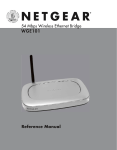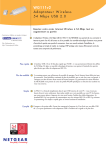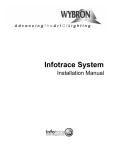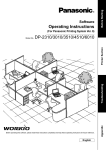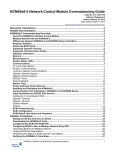Download Netgear WGE101 Reference Manual
Transcript
Table of Contents Introduction . . . . . . . . . . . . . . . . . . . . . . . . . . . . . . . . . . . . . . . . . . . . . . . . .1 System Requirements . . . . . . . . . . . . . . . . . . . . . . . . . . . . . . . . . . . . . .1 WGE101 Operating Modes . . . . . . . . . . . . . . . . . . . . . . . . . . . . . . . . . .1 WGE101 Default Wireless Configuration Settings . . . . . . . . . . . . . . . . .2 1: Preparing To Use the Smart Navigator . . . . . . . . . . . . . . . . . . . . . . . . . . . .3 Installing the Software . . . . . . . . . . . . . . . . . . . . . . . . . . . . . . . . . . . . . .3 Connecting a WGE101 Bridge to a Computer . . . . . . . . . . . . . . . . . . . .4 Identifying the Wireless Network Name (SSID), IP Address, and WEP Security Settings . . . . . . . . . . . . . . . . . . . . . . . . . . . . . . . . . .5 2: Configuring Your WGE101 . . . . . . . . . . . . . . . . . . . . . . . . . . . . . . . . . . . .6 Starting the Smart Navigator . . . . . . . . . . . . . . . . . . . . . . . . . . . . . . . . .6 Getting Status Information . . . . . . . . . . . . . . . . . . . . . . . . . . . . . . . . . .7 Changing the Country/Region Setting . . . . . . . . . . . . . . . . . . . . . . . . . .8 Selecting a Specific Wireless Network . . . . . . . . . . . . . . . . . . . . . . . . . . .9 Enabling WEP Security on the Bridge . . . . . . . . . . . . . . . . . . . . . . . . . .10 Changing the Bridge’s IP Address . . . . . . . . . . . . . . . . . . . . . . . . . . . . . .11 Configuring the Bridge for an Ad-Hoc Network . . . . . . . . . . . . . . . . . . .12 Making Advanced Settings Changes . . . . . . . . . . . . . . . . . . . . . . . . . . . .13 Troubleshooting Tips . . . . . . . . . . . . . . . . . . . . . . . . . . . . . . . . . . . . . . . . . . .14 Introduction Thank you for purchasing a NETGEAR WGE101 54 Mbps Wireless Ethernet Bridge. If the default settings on the bridge do not work, you will need to configure the bridge. If the default settings do work, you only need to configure the bridge if the network is in a country or region other than the United States or if there are multiple WGE101 bridges on the network. If you have a Windows® computer you may use the NETGEAR Smart Navigator software to configure basic connection settings on the bridge. This software is included on the WGE101 54 Mbps Wireless Ethernet Bridge Resource CD. Additionally, to make advanced configuration changes the Windows computer must have Internet browser software installed. This reference manual gives you the information you need to use the Smart Navigator to configure a WGE101 bridge. System Requirements Before installing the Smart Navigator, please make sure that these minimum requirements have been met: • You have a Windows computer with: — Windows 98SE, Me, 2000, XP — CD-ROM drive — Built-in Ethernet or an Ethernet adapter card — Microsoft® Internet Explorer 5.0 (or later) or Netscape® 6.0 (or later) WGE101 Operating Modes The WGE101 Wireless Ethernet Bridge operates in either Infrastructure or Ad-Hoc mode. • Infrastructure mode is used when you have an access point or wireless router connected to a wired network. The wireless devices and computers communicate with the wired network (and other wireless devices) through the wireless router or access point. For example, with a wireless router multiple computers (both wired and wireless) can share a single cable or DSL broadband Internet connection. • You use the bridge in Ad-Hoc mode if you have a small, wireless-only network and all the devices have wireless transmitters/receivers. In this case, there’s no need for an access point or a wireless router for the wireless devices communicate directly to one another. 1 WGE101 Default Wireless Configuration Settings The factory default settings for your WGE101 54 Mbps Wireless Ethernet Bridge are: • Mode (Infrastructure or Ad-Hoc): Infrastructure • Wireless network name Service Set Identification (SSID): Any Note: Any means the bridge will connect to the access point or wireless router that has the strongest signal. This may not be the closest access point or wireless router. For the WGE101 Wireless Ethernet Bridge to communicate with a specific wireless router or access point, both devices must be configured with the same SSID. • User ID: admin • Password: password • Authentication type: Auto • WEP security: Disabled • Country/Region: United States Warning: Having the bridge set to the wrong country or region may result in the violation of local laws. WGE101-specific default settings: • IP address: 192.168.0.201 • Protocol: Static • Device name: netgearxxxx (where xxxx is the last 4 digits of the MAC address) • Data rate: b/g combo 2 1 Preparing To Use the Smart Navigator Before you can use the Smart Navigator to configure a WGE101 bridge, you must install the software on a Windows computer and connect the bridge to that computer. Installing the Smart Navigator Software You install the Smart Navigator software from the WGE101 54 Mbps Wireless Ethernet Bridge Resource CD. To install from the CD: 1. Insert the WGE101 54 Mbps Wireless Ethernet Bridge Resource CD in the CD-ROM drive of a Windows computer. The CD should start up automatically and show a window of the resources available on the CD. If this does not happen, go to My Computer, open the CD-ROM drive, and double-click Setup.exe. 2. Click Install NETGEAR Smart Navigator. 3. Follow the instructions on screen to install the software. 3 Connecting a WGE101 Bridge to a Computer To configure the bridge using the Smart Navigator, the bridge must be directly connected or connected through a switch (or hub) to a Windows computer. For example, if the bridge is connected to a game box, you’ll have to connect the bridge to a computer to be able to configure the bridge. To make any advanced settings changes (like changing the bridge’s password or upgrading the bridge’s firmware), the computer must have an Internet browser installed. To connect the bridge to a computer: 1. If your network has a wireless router or access point, make sure it is powered up. 2. Power down the Ethernet-enabled computer. 3. Connect the provided Ethernet cable between the computer and the bridge. 4. Connect the power adapter to the bridge and plug the power adapter in to a power outlet. The Power and Wireless LAN lights should light up. 5. After you see the Wireless LAN light Ethernet-enabled Windows computer WGE101 54 Mpbs Wireless Ethernet Bridge light up, turn on the computer. If the bridge and the Ethernet-enabled device are successfully connected, the Network light will light up. This light flashes when there is network activity. To connect the bridge and computer through a switch (or hub): 1. If your network has a wireless router or access point, make sure it is powered up. 2. Power down the Ethernet-enabled computer. 3. Connect the provided Ethernet cable between the bridge and the switch (or hub). 4. Connect the computer to the switch (or hub) using an Ethernet cable. 5. Connect the switch’s (or hub’s) power adapter and plug that power adapter in to a power outlet. 6. Connect the bridge’s power adapter and plug the power adapter in to a power outlet. The Power and Wireless LAN lights should light up. 7. After the Wireless LAN light Fast Ethernet Switch FS605 WGE101 54 Mbps Wireless Ethernet Bridge Ethernet-enabled Windows computer lights up, turn on the computer. If the bridge, switch, and the computer are successfully connected, the Network light will light up. This light flashes when there is network activity. 4 Identifying Your Wireless Network Settings You may want to print this page separately, fill in the configuration parameters, and put it in a safe place for possible future reference. For an existing wireless network, the person who set up the network will be able to provide this information. Note: For wireless devices and the bridge to communicate with each other, each must be configured with the same SSID, WEP security settings, and the same IP subset address. • Wireless Network Name (SSID): The Service Set Identification (SSID) identifies the wireless local area network. Any is the default WGE101 SSID. If you have named your wireless network with a different SSID, write your network’s SSID on the line below. Wireless network name (SSID): ______________________________ • Bridge IP Address: Your Ethernet network has an IP subset address given as a set of three numbers plus a last set of unique numbers (xxx.xxx.xxx.yyy) to identify each device on the network. The default IP address for the bridge is 192.168.0.201. To communicate to your Ethernet network, each bridge must have a unique address consistent with your network’s IP subset address. If you need to change the bridge’s IP address, write down the new address. Bridge’s IP address: ______________________________ • WEP Security Encryption key: The default WEP encryption mode of the bridge is disabled. If you have set up WEP security on your wireless network (through the router or access point), you’ll need to configure the bridge using the same WEP security parameters. WEP Encryption Key Length, circle one: 40/64 or 128 bits WEP Encryption Passphrase, if used: ___________________ A passphrase is used to automatically generate the WEP hexadecimal numbers for the key. Otherwise, you will have to manually enter up to four hexadecimal numbers. WEP Hexadecimal Numbers: ______________________________ ______________________________ ______________________________ ______________________________ 5 2 Configuring Your WGE101 This section provides instructions for configuring the WGE101 Bridge using the Smart Navigator. You use the Smart Navigator, itself, to change basic settings: • Network Name (SSID) • Country/Region • Network Type (Infrastructure/Ad-Hoc) • Security Settings • IP Address To change more advanced settings, you use the bridge’s internal configuration software using an Internet browser. In addition to the basic settings, you can make the following changes using the browser-based software: • Changing the password. • Setting the bridge’s data rate/channel. • Upgrading the bridge’s firmware. • Restoring the factory default settings. For details on using the browser-based configuration software see the WGE101 Reference Manual on the WGE101 54 Mbps Wireless Ethernet Bridge Resource CD. Starting the Smart Navigator 1. Choose Programs>NETGEAR WGE101 Bridge>Smart Navigator from the Start menu. When the Smart Navigator opens, it searches for any connected WGE101 Bridge. When located, any bridge appears in the device list at the top. 2. Select the bridge that you want to configure. 3. To configure basic connection settings, click Connection Settings. OR To configure more advanced settings or the IP address, click Advanced Settings. Type admin as the User name and the current password. (password is the default.) Click OK. 4. To refresh the device list, click Scan. 6 Getting Status Information 1. Choose Programs>NETGEAR WGE101 Bridge>Smart Navigator from the Start menu. When the Smart Navigator opens, it searches for any connected WGE101 Bridge. When located, any bridge appears in the Smart Navigator device list at the top of the window. 2. Select the bridge about which you want status information. 3. Click Status. The Bridge Status window gives you current information about: • Network Name (SSID) • Connection Status • Country/Region • Channel • Security • Transmitted and received data packets • Signal Strength • Bridge IP Settings • Bridge NetBIOS Name • MAC Address • Firmware version number 4. Click Refresh to update the status information. 5. Click Close to return to the Smart Navigator device list. 7 Changing the Country/Region Setting Before making any other changes you should make sure that the bridge is configured to operate where the network is located. 1. Choose Programs>NETGEAR WGE101 Bridge>Smart Navigator from the Start menu. 2. Select the bridge in the device list. 3. Click Connection Settings. 4. To change the Country/Region, select a different country or region and click OK. Note: Having the wrong Country/Region setting may violate local laws. 5. To apply the change, type admin as the User name and password as the Password. 6. Click OK. 7. Click Yes. 8 Selecting a Specific Wireless Network By default, the WGE101 connects to the wireless router or access point with the strongest signal. This may not be the closest or the desired network. To have the bridge connect to a specific network, you change the Network Name (SSID) setting. If you filled in the Network Name (SSID) on page 5, you may want to refer to it for this procedure. 1. Choose Programs>NETGEAR WGE101 Bridge>Smart Navigator from the Start menu. 2. Select the bridge in the device list. 3. Click Connection Settings. 4. To connect to a specific network, select its name in the Network Name (SSID) list. or Type the network’s SSID in the Network Name (SSID) box. 5. Click OK. 6. To apply the change, type admin as the User name and the current password. (password is the default.) 7. Click OK. 9 Enabling WEP Security on the Bridge To prevent others from accessing your wireless network, you may want to enable WEP (Wired Equivalent Privacy) security in your wireless router or access point. If you do so, you’ll need to enable WEP security in the bridge, too. If you filled in the parameters on page 5, you may want to refer to them for this procedure. Note: The default security setting has WEP security disabled. 1. Choose Programs>NETGEAR WGE101 Bridge>Smart Navigator from the Start menu. 2. Select the bridge in the device list. 3. Click Connection Settings. 4. To enable WEP security click the Use WEP Encryption check box. 5. If the key is determined through software, select Create with Passphrase, type the phrase in the Passphrase box, and select a key length of 64 bits or 128 bits. OR If you entered specific keys for your wireless router or access point, select Enter Key Manually, select a Key number, type the hexadecimal value for that key, and select a key length of 64 bits or 128 bits. 6. Click OK. 7. To apply the change, type admin as the User name and the current password. (password is the default.) 8. Click OK. 10 Changing the Bridge’s IP Address If your wireless network has an IP address other than 192.168.0.yyy, you need to change the IP address on the bridge or set it to be configured automatically by the router. Note: All NETGEAR products use 192.168.0.yyy. If you have NETGEAR wireless products working in your wireless network without configuration changes, you won’t need to change the bridge’s IP address unless you have more than one WGE101 bridge on the network. 1. Choose Programs>NETGEAR WGE101 Bridge>Smart Navigator from the Start menu. 2. Select the bridge in the device list. 3. Click Advanced Settings. 4. If the warning appears about the IP address not matching that of the network, click Yes. Note: If you’re asked for the User name and Password at this point, that means that the bridge’s IP address matches that of the network. Type admin as the User name and the current password. (password is the default.) Click OK. See the WGE101 Reference Manual for details on using the browser-based software for changing the IP address. 5. Click Suggested Settings. The Smart Navigator suggests an IP address and subnet mask that match that of your wireless network. 6. If you don’t like the suggested address, change the numbers as needed. The first three sets of numbers (xxx.xxx.xxx.yyy) should be the same as your access point or router. The last set of numbers (.yyy) should be a set of unique numbers on your network. OR If your network has a router with a router table, select Obtain IP Address automatically. (By doing this, the bridge’s IP address is assigned dynamically by the router and you’ll use the router table to find out what the bridge’s current IP address is.) 7. Click OK. 8. To apply the change, type admin as the User name and the current password. (password is the default.) 9. Click OK. 11 Configuring the Bridge for an Ad-Hoc Network You may use this bridge in a wireless-only network where the wireless devices are all set to AdHoc mode. By default, the bridge is set to Infrastructure mode; therefore, you’ll need to change the Network Type. Note: In an Ad-Hoc network, all devices must have the same SSID, WEP settings, and IP network subset address with a unique identifying number (xxx.xxx.xxx.yyy). 1. Choose Programs>NETGEAR WGE101 Bridge>Smart Navigator from the Start menu. 2. Select the bridge in the device list. 3. Click Connection Settings. 4. Select Ad-Hoc as the Network Type. 5. If you are setting up the Ad-Hoc network, type a SSID for the network in the Network Name (SSID) box. OR If the Ad-Hoc network already exists, select the correct SSID in the Network Name (SSID) list. 6. Click Initialize. 7. Select the type of 802.11 network. 8. Select the Channel (with frequency) for this network. Note: If you’re setting up a new Ad-Hoc network, select a channel and frequency that isn’t being used by other nearby wireless devices. 9. Click OK. 10. Click OK. 11. To apply the change, type admin as the User name and the current password. (password is the default.) 12. Click OK. 12 Making Advanced Settings Changes You can use the bridge’s internal configuration software to make basic settings changes and any advanced setting changes such as: • Changing the password. • Upgrading the bridge’s firmware. • Restoring the factory default settings. • Changing the IP address if the default address does work with your network. You can access the bridge’s internal configuration software either through the Smart Navigator or through an Internet browser. To access the internal configuration software through the Smart Navigator: 1. Choose Programs>NETGEAR WGE101 Bridge>Smart Navigator from the Start menu. 2. Select the bridge in the device list. 3. Click Advanced Settings. 4. Type admin as the User name and the current password. (password is the default.) Note: If you get a warning that the IP address doesn’t match, see the Changing the Bridge’s IP Address procedure on page 11. 5. Click OK. For details on using the browser-based configuration software see the WGE101 Reference Manual on the WGE101 54 Mbps Wireless Ethernet Bridge Resource CD. 13 Troubleshooting Tips If you have problems using the Smart Navigator software, check these tips. Symptom Cause Solution The WGE101 doesn’t show up in the device list. There’s a hardware problem. • Check that the bridge’s power light is on. • Check that the Ethernet cable is securely connected to both the computer and the bridge. • If operating through a switch (or hub), check that the bridge’s and the switch’s (or hub’s) power lights are on. • If operating through a switch (or hub), check the Ethernet cable connections between the computer and the switch (or hub) and between the bridge and switch (or hub). 14 Technical Support PLEASE REFER TO THE SUPPORT INFORMATION CARD THAT SHIPPED WITH YOUR PRODUCT. By registering your product at www.NETGEAR.com/register, we can provide you with faster expert technical support and timely notices of product and software upgrades. NETGEAR, INC. Support Information Phone: 1-888-NETGEAR (for US & Canada only), available 24x7. For other countries see your Support Information card. E-mail: [email protected] (24x7 online support) www.NETGEAR.com 0560 ! Attention: When you configure the wireless settings of this device please make sure to select the correct country settings. Due to EU-law, the country settings must be identical to the country where the device is operating (important due to non-harmonized frequencies in the EU). ©2003 by NETGEAR, Inc. NETGEAR, the Netgear logo, Everybody’s Connecting, Auto Uplink and The Gear Guy are trademarks or registered trademarks of Netgear, Inc. in the United States and/or other countries. Microsoft and Windows are trademarks or registered trademarks of Microsoft Corporation in the United States and/or other countries. Other brand or product names are trademarks or registered trademarks of their respective owners. Information is subject to change without notice. All rights reserved. July 2003

















